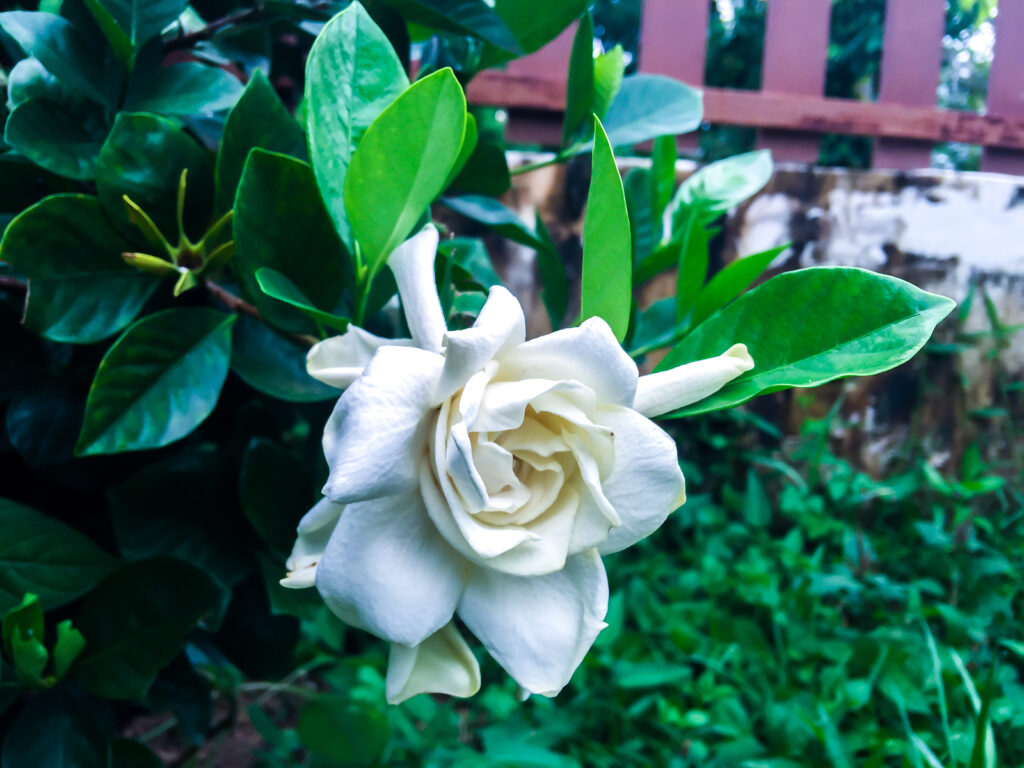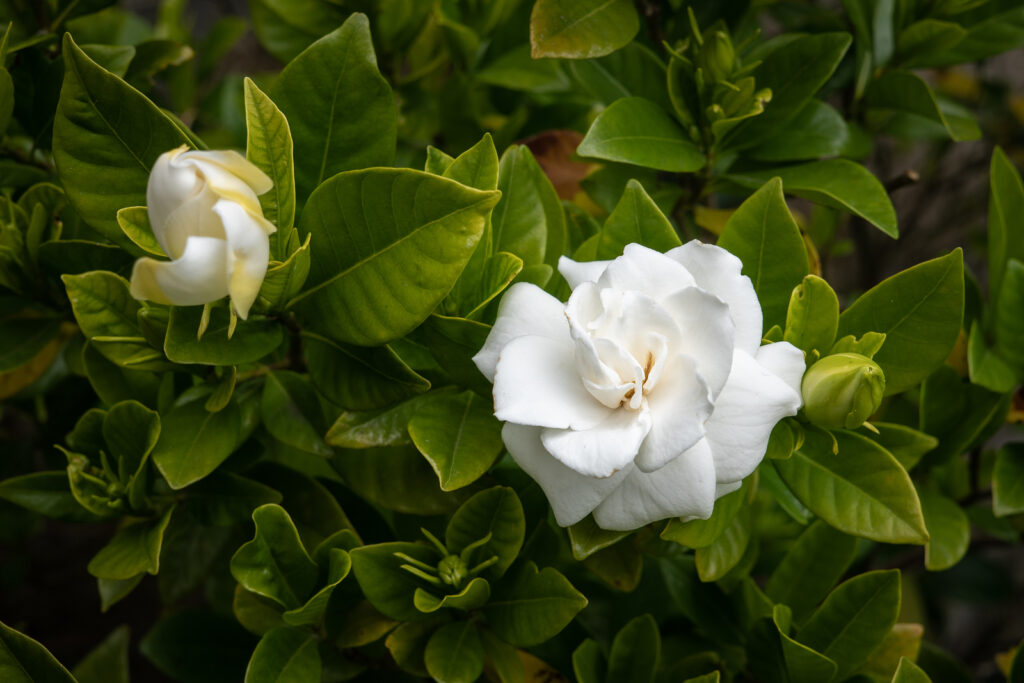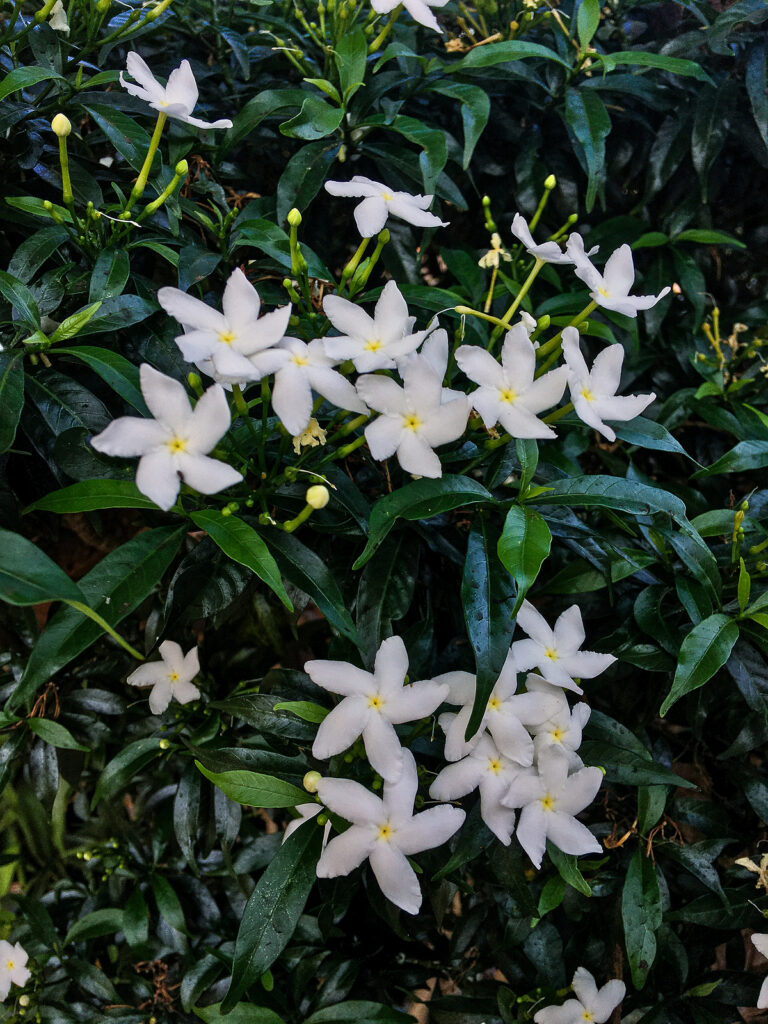Gardenia has intensely fragrant, creamy white, waxy summer flowers. Flowers can be single, semi-double, or double white and bloom in succession over a long period.
Gardenia is an evergreen shrub with glossy, thick leathery leaves. Gardenia flowers are tubular to funnel-shaped. Flowers each have 5 to 12 spreading [petal lobes. Leaves are opposite or whorled.
In warm-winter regions grow Gardenia in a shrub border or in containers. In cold winter regions grow Gardenia indoors or in a temperate or warm greenhouse.
Gardenia is a genus of about 200 species of evergreen trees and shrubs native to tropical woodlands and savanna of Africa and Asia.

Get to know Gardenia
- Plant type: Evergreen early summer-blooming shrub
- Growing Zones and range: Zones 8 to 11
- Hardiness: Survives to 0°F/-18°C but dies back to the ground; hardy to 10°F without damage
- Height and width: 2 to 6 feet (0.6-1.8m) tall, and 3 to 6 feet (101.8m) wide
- Foliage: Simple leathery leaves are opposite
- Flowers: To bloom plant needs temperatures 55° to 60°F (13°-16.6°C at night and warm during the day; outstanding fragrance
- Bloom time: Succession of blooms in summer
- Uses: Foundation plant, specimen, container plant, cut flowers
- Common name: Gardenia
- Botanical name: Gardenia augusta (Gardenia jasminoides)
- Family: Rubiaceae
- Origin: Tropical regions of Africa and Asia
Where to plant Gardenia
- Plant gardenia in full sun to light shade.
- Grow gardenia in well-drained, humus-rich, moist, and acidic soil.
- Where the soil is poor-draining grow in large pots.
- Site Gardenias near a sidewalk, deck, or window where the fragrance can be savored.

When to plant Gardenia
- Set gardenia in the garden in spring.
Planting and spacing Gardenia
- Space gardenia 3 to 6 feet (1-1.8m) apart.
- Gardenias should be planted shallowly, like azaleas and rhododendrons, or in a container.
How to water and feed Gardenia
- Gardenia needs ample moisture; keep the soil evenly moist.
- Fertilize gardenias monthly with an acidic fertilizer.

Gardenia care
- Gardenia roots don’t tolerate competition or heavy cultivation, so mulch them well.
- Deadhead Gardenias regularly or prune just lightly in spring unless espaliered.
- Mulch around gardenia with aged compost or sphagnum peat moss; this feeds the plant and conserves soil moisture.
- Prune gardenia only to remove straggly branches or trim spent blooms.
Growing Gardenia as a houseplant
- Gardenia jasminoides, Cape jasmine, is an evergreen that frow 12 to 36 inches (30-91cm) indoors.
- Gardenia prefers a warm room, indirect light, and high humidity.
- For flower buds to set the night temperature must be at least 60°F (15.6°C).
- Grow Gardenia in a soilless, acidic, well-drained medium.
- Fertilize Gardenia monthly with plant food for acid-loving plants.
- Pinch growing tips to encourage branching; stop pinching five months before the desired bloom date.
- If winter bloom is desired, remove any flower buds that form before mid-autumn.
- Flower buds will drop if the air is too dry or if the plant receives insufficient light.
- If new growth turns yellow, iron chlorosis may be the problem; tree with iron sulfate.
Gardenia pests and diseases
- Gardenia can develop powdery mildew, bacterial leaf spots, anthracnose, dieback, fungal leaf spots, and stem cankers, as well as a root-knot nematode.
- Gardenia is susceptible to attacks by whiteflies and mealybugs indoors and scale insects, aphids, and thrips outdoors.
- Lessen disease problems by providing adequate air circulation.

Gardenia propagation
- Sow Gardenia seed at 66-75°F (19-24°C) in spring.
- Take semi-ripe cuttings in late summer.
- Root greenwood cuttings in spring or summer
Gardenia varieties to grow
- Gardenia Augusta (G. jasminoides), Cape jasmine, Common gardenia, medium to large shrub, or sometimes small tree, frequently bushy, with ovate, elliptic, or lance-shaped, glossy, deep green leaves, 4 inches (10cm) or longer, usually borne in whorls of 3. From summer to autumn, produces 5- to 12-lobed, salverform, strongly fragrant, white to ivory flowers, to 3 inches (8cm) across, either singly or in its double-flowers variants. To 6-40 inches (2-12m) tall and 3-10 feet (1-3m) wide. China, Taiwan, and Japan. Zones 8 to 11. Cultivars include: ‘August Beauty’ is compact and long blooming; ‘Mystery’ has semi-double flowers; ‘Radicans’ is low growing and has small flowers; ‘Veitchii’ has fully double pure white flowers.
- G. thunbergia, White gardenia, open, erect shrub or small tree with rigid branches and opposite pairs of elliptic, glossy, dark green leaves, 3-5.5 inches (8-14cm) long, with wavy margins. From winter to spring, bears solitary, tubular, fragrant, white or cream flowers, to 2.5 inches (6cm) across, with 8 spreading petal lobes. To 6-15 feet (2-5m) tall and 5-8 feet (1.5-2.5m) wide. South Africa.
Gardenia frequently asked questions
Q: Can gardenia be grown as a houseplant?
A: Yes, if you can give it the right temperature and sufficient humidity.
Q: What type of soil do gardenias thrive in best?
A: Gardenia prefers acid soil with a pH of 5 to 5.5. Yellowing foliage is an indication the soil may be alkaline.
Q: What is a good soil mix for gardenias?
A: Two parts loam, 1 part peat moss, 1/2 composted cow manure, 1/2 sharp sand.
Q: What is the best fertilizer for gardenias?
A: A 4-12-4 or 5-10-5 organic fertilizer is recommended.
Q: Why are the tips of my gardenia leaves turning yellow?
A: This may be an iron deficiency. Add iron sulfate to the water following the container directions. High heat and low humidity can also cause leaves to yellow; put the plant in a cooler location and promote humidity–set the pot on a tray of pebbles with water just below the top of the pebbles.
Q: When is the best time to repot gardenias?
A: Repot gardenias every 2 to 3 years. Repot gardenias from mid-spring to late summer. Allow time for roots to grow before winter.
Q: When is the best time to prune gardenias?
A: Prune gardenias from spring to late summer. Pruning consists of pinching out growing tips.
Q: What causes gardenias to dry up and leaves to become brittle and drop?
A: Gardenias need high atmospheric humidity. This can be difficult in a warm house. Mist the leaves frequently. You can also try covering the plant with a plastic bag to create a humid atmosphere.
Q: What is the right way to water potted gardenias?
A: Keep the soil evenly moist during the growing time. If the soil goes dry, set the pot in a bucket filled with water. Let it stay until the soil feels moist. Reduce watering in winter.
Q: How do you make gardenias bloom indoors?
A: You must provide the right conditions. Flower buds appear on new growth at temperatures of 60° to 65°F at night and 70° to 75°F during the day. An even temperature and careful watering are needed to prevent bud drop.
Q; Can I propagate gardenias from cuttings?
A: Cuttings of young terminal shoots that are firm but not hard and woody can be rooted in winter and spring. Dip the cutting in a rooting hormone. Insert the cutting into sand or sand and peat moss from mid-winter to spring. Maintain the sand at 75°F using bottom heat. Humidity is important; set the pot in a clear plastic bag or under a humidity dome.
Q: What are the white, wooly insects that cluster on my gardenia?
A: These are probably mealybugs. Wash them off with a forceful stream of water. You can also remove them with a Q-tip dipped in rubbing alcohol.















